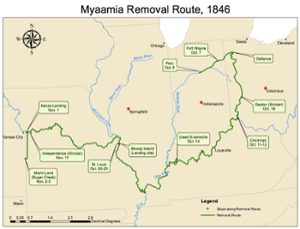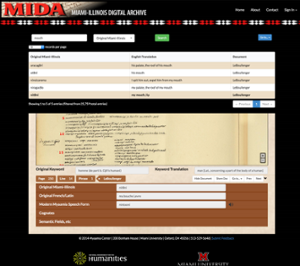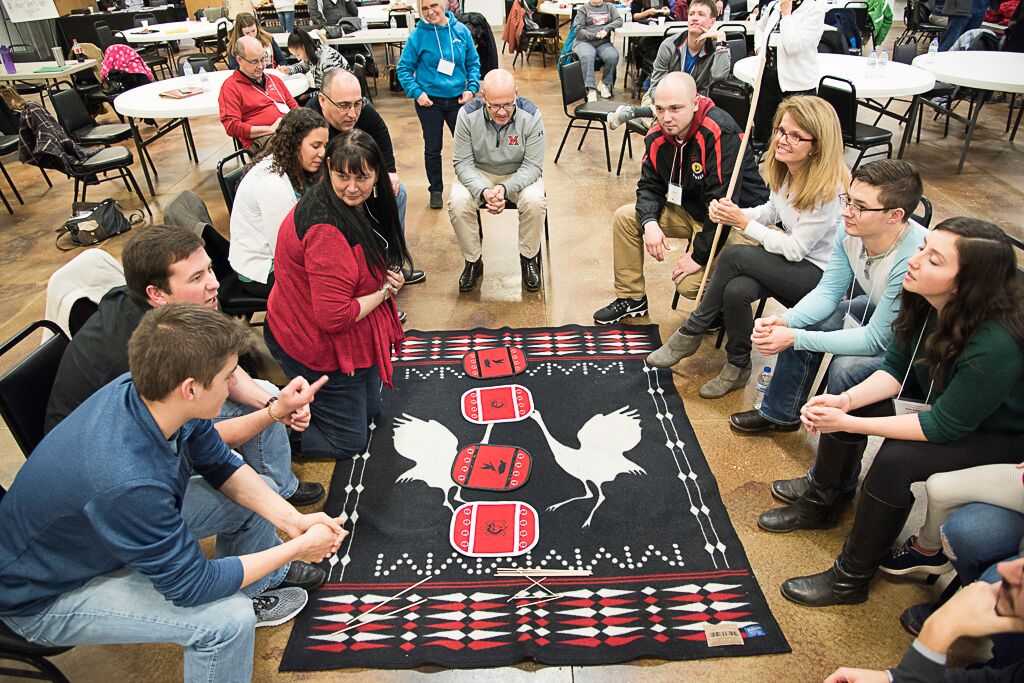CSE Helps Reconstruct Myaamia Language

 Myaamia Removal Route 18461
Myaamia Removal Route 18461
Over four decades in the nineteenth century, the Miami tribe was removed militarily from their ancestral lands in the Great Lakes Region of North America to territory that became Kansas, and then from Kansas to what is now Oklahoma. The tribe became splintered in several different territories. With this splintering it became more difficult to maintain their culture, and the Miami language fell out of use by the mid-1900s.
Discovering Documentation of the Language
In the 1980s, a grad student at the University of California-Berkeley, David J. Costa, managed to find 250 years of extensive documentation on the language, mostly in the form of unpublished manuscripts. This documentation wasn’t up to modern phonetic standards, but it did provide a starting point with which to reconstruct the language. In the 1990s, the Miami Tribe of Oklahoma became interested in revitalization of their language, and teamed up with Miami University to create the Myaamia Center in 2001. A central focus of this center was to revitalize the language and create an online dictionary and catalog of all the documents.
Bringing the Language to Life with Technology
 MIDA, Miami-Illinois Digital Archive.2Dr. Doug Troy of the CSE department became involved with creating software to serve as learning tools for the Miami Tribe to learn their language. Previous language learning software required recordings of native speakers to understand the phonetics of the language, but because there are no living native speakers of the Miami language, they had to do something different. Dr. Troy, along with numerous grad students and undergrads, created a brand new type of software, and through collaborations with linguists, anthropologists, translators, and historians, they have an idea of what the language sounded like. Although, according to the director of the Myaamia Center, Daryl Baldwin, the word pronunciation is undoubtedly with an American accent, there has been real progress in archiving the primary documents, recording the language, and creating an interactive dictionary.
MIDA, Miami-Illinois Digital Archive.2Dr. Doug Troy of the CSE department became involved with creating software to serve as learning tools for the Miami Tribe to learn their language. Previous language learning software required recordings of native speakers to understand the phonetics of the language, but because there are no living native speakers of the Miami language, they had to do something different. Dr. Troy, along with numerous grad students and undergrads, created a brand new type of software, and through collaborations with linguists, anthropologists, translators, and historians, they have an idea of what the language sounded like. Although, according to the director of the Myaamia Center, Daryl Baldwin, the word pronunciation is undoubtedly with an American accent, there has been real progress in archiving the primary documents, recording the language, and creating an interactive dictionary.
“This is a really meaningful project to reclaim lost language and culture,” Dr. Troy said.
Creating a Community
This project has also employed the talents of numerous grad students and undergraduate students. Several senior capstone projects have worked with the Myaamia Center on this challenge, and graduate students can receive a stipend from the Myaamia Center to do this work.
 Photo Credit: Karen L. Baldwin3
Photo Credit: Karen L. Baldwin3
Daryl Baldwin has had positive experiences working with the students, who, he says, “like to work on a real world project that benefits the community.”
One such student, Amlaan Shakeel, who will be graduating with a master’s degree in electrical engineering this year, has had a particularly positive relationship with the Myaamia Center. He was invited to travel down to Oklahoma to participate in the tribe’s annual Stomp Dance.
Amlaan described the event as upbeat and fun, where different tribes got together and danced and told stories. They were also excited the language app was out. “You could see them really trying hard to make the language known to each other,” Amlaan recalled.
President Crawford also participated in the Stomp Dance this year. “He was pretty active and he talked to all the chiefs and students,” Amlaan recalled, and he bought the students t-shirts, which they loved.
The collaboration between the College of Engineering & Computing and the Miami Tribe proves that being an engineer or computer scientist is not all about math and science, but about understanding unique challenges and coming up with innovative solutions that help real people.
Go to the Myaamia Center website for more information on its work and the history of the Miami Tribe.
By Paige Smith
.
1'Myaamia Removal Route, 1846'. This material is based upon work assisted by a grant from the Department of Interior, National Park Service.
2MIDA, Miami-Illinois Digital Archive. A Miami Language Digital Tool for Language Reclamation. A screen shot of a typical search result.
32017 Stomp - Miami Tribe of Oklahoma Chief Doug Lankford, Business Committee Member, Donya Williams, Miami University President Greg Crawford and Miami tribe members play 'mahkisina eeyoonki meehkintiinki' (moccasin game) a traditional Myaamia game. Photo credit: Karen L. Baldwin

